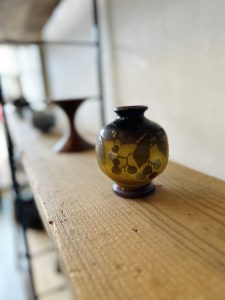ガラスの中に閉じ込めた自然(愛知県名古屋市千種区姫池通 骨董買取 古美術風光舎)
2024.02.17
皆さまこんにちは。スタッフHでございます。
関東地方では昨年より14日早く「春一番」が吹いたようですね。寒いのは苦手ですが、2月にこの暖かさはいかがなものかと不安にもなります。
自然の前では人間は小さく無力だともいいます。他の生き物同様、地球に住まわせてもらっているという謙虚な気持ちを忘れず持ち続けたいです。
さて身近にある自然を真摯に見つめ続けたエミール・ガレの作品が店内にございます。改めてご紹介するまでもないとは思いますが、19世紀末から20世紀初頭に活躍したフランスのガラス工芸家で、家具デザイナーでもあり、工場経営者でもありといくつもの顔を持った才能に溢れた人物です。
店内にございます小さな花瓶。小ぶりですがずっしりと重みを感じ、ガレの世界を両手に包み込めるような贅沢感があります。また手のひらに感じる凹凸が心地よく、つい指でもなぞりたい衝動にも駆られます。

ヤツデの葉でしょうか。実や花ではなく葉が主役であるかのように小さい花瓶いっぱいにのびやかに広がっています。写真では分かりにくいですが、葉の一枚一枚の色が微妙に違い、そのグラデーションの美しさに引き込まれます。
鮮やかな色ではなくこの影絵のような暗い色調は、色に深みを与え自然の色に近づけるというガレの作品の特徴でもありますが、初めからこの独特の深い色合いではなかったようです。
父親のガラス工場を引き継いだ19世紀半ばはまだ無色透明のガラスが人気で、光をキラキラ反射する鉛クリスタルが価値のあるものとされ、ガレも多く制作していたとのこと。
しかし哲学、文学、音楽、自然学などの知識が豊富で、溢れる美術的才能を持っていたガレは型にはまった作品を超越し、精神的ともいえる独自の世界を切り開いていきます。後世に名を残す芸術家には概ねこのような魅力的な人物が多いですね。
この自然と調和する世界観には日本の美術工芸の影響も少なからずあったようです。19世紀末、ヨーロッパ中を駆け抜けた新しい芸術スタイルのアールヌーボー。そのスタイルは産業革命で生まれた大量生産の製品にどこか疑問を持っていた当時の人々に広く受け入れられました。その中でジャポニスムと呼ばれる東洋人の感性が反映された工芸品が人気となりました。欧米の人には珍しく、草花や虫をこよなく愛したガレと日本人の感性は近いものがあったのかもしれません。
その当時、高島北海という明治政府の役人がフランスのナンシーに派遣され、エミール・ガレとも交流があったようです。北海の影響によりガレの作品には日本的な余白を活かした表現や墨絵の黒が反映されていると言われています。

ロレーヌの田舎や、親しんだ庭園を散歩し植物についての深い知識を深めていったエミール・ガレ。座右の銘として「我が根は森の奥深くにあり」という座右の銘を工場の入り口に掲げていたとされています。作品にも生と死をテーマにしもの多く残っているといいます。なかなか実物を見ることはできないかもしれませんが、本や映像で出来るだけ沢山の作品に触れ、楽しみたいと思います。
それでは、また次の機会に。
明日2月18日(日)10:00~風光舎の店舗にて「持込鑑定会」を行います。
ご予約等は不要ですので、ご都合の良い時間にふらっとお立ち寄りください。
お待ちしております。
Hello everyone. This is Staff H.
It seems that the “first day of spring” blew 14 days earlier than last year in the Kanto region. I don’t like cold weather, but I also feel uneasy about this warmth in February.
It is said that human beings are small and helpless in front of nature. Like other living creatures, I would like to keep in mind the humble feeling that we are allowed to live on the earth.
Now, we have a work by Emile Gallé, who continued to look at nature with great sincerity, in our store. He was a French glass craftsman, furniture designer, and factory owner who was active from the end of the 19th century to the beginning of the 20th century.
A small vase in the store. It is small in size, but it feels very heavy and luxurious, as if the world of Galle could be wrapped in both hands. The unevenness of the surface on the palm of the hand is so comfortable that one is tempted to trace the surface with one’s fingers.
Is it a leaf of a lamprey? The leaves, not the fruits or flowers, are the main attraction, spreading out in a small vase. It is hard to tell from the photo, but the color of each leaf is slightly different, and the beauty of the gradation draws you in.
The dark, shadowy tones, rather than the vivid colors, are characteristic of Galle’s work, which gives depth to the colors and brings them closer to the colors of nature, but it does not seem to have been this unique deep hue from the beginning.
When he took over his father’s glass factory in the mid-19th century, colorless transparent glass was still popular, and lead crystal, which reflects sparkling light, was considered valuable, and Galle produced a lot of it.
However, Galle’s abundant knowledge of philosophy, literature, music, and natural science, as well as his abundant artistic talent, allowed him to transcend conventional works, opening up a world of his own that could be described as spiritual. Many of the artists who have left their mark in later generations are generally such fascinating figures.
This view of the world in harmony with nature seems to have been influenced in no small part by Japanese arts and crafts. This style was widely accepted by the people of the time, who were somewhat skeptical of the mass-produced products born of the Industrial Revolution. Among them, crafts that reflected the sensibility of Oriental people, known as Japonisme, became popular. Perhaps the Japanese sensibility was close to that of Galle, who loved plants, flowers, and insects, which was rare for people in Europe and the United States.
At that time, an official of the Meiji government named Takashima Hokkai was dispatched to Nancy, France, where he also had contact with Emile Gallé. It is said that under Hokkai’s influence, Galle’s works reflect the Japanese expression of marginal spaces and black ink painting.
Emile Gallé deepened his knowledge of plants through walks in the Lorraine countryside and in the gardens he enjoyed. It is said that he hung his motto, “My roots are deep in the forest,” at the entrance to his factory. It is said that many of his works have the theme of life and death. It may be difficult to see the actual works, but I would like to enjoy them through books and videos as much as possible.
See you next time.
Tomorrow, February 18 (Sun.) from 10:00 a.m., we will hold a “Bring Your Own Appraisals” session at the Fuhkosha store.
Reservations are not required, so please drop by at your convenience.
We look forward to seeing you there.
*******************
ご実家の整理やお片付けなどをされている方のご相談などが多くございます。
お片付けなどくれぐれもご無理のないようになさってくださいませ。
風光舎では古美術品や骨董品の他にも絵画や宝石、趣味のお品など様々なジャンルのものを買受しております。
お片付けをされていて、こういうものでもいいのかしらと迷われているものでも、どうぞお気軽にご相談下さいませ。
また風光舎は、出張買取も強化しております。ご近所はもちろん、愛知県内、岐阜県、三重県その他の県へも出張いたします。
まずは、お電話お待ちしております。
愛知県名古屋市千種区姫池通
骨董 買取【古美術 風光舎 名古屋店】
TEL052(734)8444
10:00-18:00 OPEN
#骨董買取#古美術買取#出張買取#無料査定#生前整理#遺品整理#家じまい#実家じまい#掛け軸#絵画#木箱入り茶碗#刀剣#洋食器#貴金属

